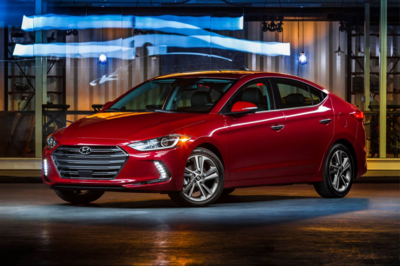HEELS ON WHEELS: 2017 HYUNDAI ELANTRA ECO AND 2017 HYUNDAI ELANTRA HYBRID REVIEW
HEELS ON WHEELS
By Katrina Ramser
San Francisco Bureau
The Auto Channel
INTRO TO THE ELANTRA VEHICLE
Hyundai’s sporty Elantra offers a versatile mid-size sedan experience for a reasonable cost: go with the upgraded Limited trim, for example, or save fuel with the Eco trim that retains 35 miles-per-gallon combined – both won’t break your budget. There is even a performance-focused GT hatchback version. All offer spot-on styling and customer-focused technology.
I drove a 2017 Hyundai Elantra Eco with the 128-horsepower 1.4-liter turbo four-cylinder engine well as the Limited with the 147-horsepower 2-liter four-cylinder engine. (And just last year I also drove the GT hatchback version with the 173-horsepower 2-liter Nu engine with a six-speed automatic transmission with SHIFTRONIC). The Elantra is available in five trims — the base SE, Value Edition, Eco, Sport and Limited — with standard equipment including: premium cloth upholstery; steering-wheel mounted controls; sliding center armrest; a six-speaker audio system; iPod and USB input jacks; XM Radio; a six-speed manual transmission; and Driver’s Blind Spot. Price as described for a base Elantra SE comes to $17,150 with the Eco at $20,650 and the Limited at $22,350.
Fully redesigned for the model year the Elantra adds a new exterior look, a revised cabin with better technology, and retuned engines. A competitor that can offer similar savvy style and smart fuel economy includes the Ford Fusion Hybrid.
HEELS ON WHEELS REVIEW CRITERIA
Stylish But Comfortable Results: The Elantra’s design commands a second glance for a sporty looking sedan that appears more expensive than it actually is. However, I’d step up to the Value Edition trim that adds such notables as a power driver’s seat, heated front seats, a sliding armrest, push-button start, Bluetooth, and safety tech like a rearview camera and Blind Spot Detection. Better yet, the Limited gains leather upholstery, Blue Link Connected Care, an eight-inch display with navigation, Android Auto and Apple CarPlay. But even at the top-of-the-line trim you still need to pay extra for a moonroof, an Infinity audio system with Clar-fi enhancements, a bigger instrument display screen and heated rear seats. What’s refreshing in this technology age is the climate controls remain as easy-to-access dials when many makers have switched to button commands, or worse – temperature controls only accessible through a digital screen.
Reliability & Safety Factor: The Insurance Institute for Highway Safety (IIHS) gives the 2017 Hyundai Elantra sedan model a Top Safety Pick rating with ratings pf “Good” in all areas omitting ease of use with LATCH (inserting child seats). I’d also like to comment my five-year old experienced frustration with clicking in her own belt. The National Highway Traffic Safety Administration (NHTSA) gives the hatchback sedan version an overall rating of 4-Stars (yet the hatchback gets 5-Stars). Standard safety equipment includes electronic stability control, vehicle stability management, traction control, anti-lock brakes, brake assist, and an advanced airbag system. A review camera and Blind Spot Detection are standards starting with the Value Edition, but any additional safety technology options like Lane Keep Assist and Forward Collision Warning are paid extras on the Limited only.
Cost Issues: The great new it’s not going to cost you much to get a good deal as the Eco is $20,650 and my fully loaded Limited with options a tame $27,710. A recent Ford Fusion Hybrid test drive with options cost $35,155.
Activity & Performance Ability: Still too restrained to be labeled sporty or aggressive, the Elantra has picked up some kick with the Eco and Limited four-cylinders but lacks what the Fusion and Mazda’s SKACTIV-G technology can do. Hyundai has revised the power steering for a better road feel, and it does overall ride like a larger vehicle.
The Green Concern: Fuel economy is a strong point with the 2-liter four-cylinder engine retaining 28 miles-per-gallon city and 37 highway for a combined 32; and the 1.4-liter Eco version getting 32-city and 40-highway for a combined 35. The Mazda6’s 184-horsepower 2.5-liter four-cylinder can get 29 miles-per-gallon while the Ford Fusion Hybrid has 42 combined.
FINAL PARTING WORDS
Versatility, defining style and a low price make the 2017 Hyundai Elantra an attractive sedan choice — but when pitted against competitors with better road performance, this vehicle sheds a few appeal points.
©2017 Katrina Ramser Parrish
The Most In-Depth Independent Hyundai Buyer's Research - Anywhere!
- Ready To Buy? Save Hundreds As An Unencumbered Free-to-the-Dealer Independent Buyer
- Hyundai Buyers Guide | Specs, Prices, Expert Reviews and Comparisons 2017-1997
- Find Your Perfect New Car Match
- Hyundai Reviews From The Auto Channel (1993-Present)
- The Auto Channel's Hyundai Brand Archives; News, Press Releases, Reviews, Specifications, Prices, Video, Images (47,008 Annotations)



